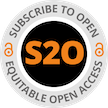Recent Issues
Volume 19, 1 issue
Volume 18, 10 issues
Volume 18
Issue 10, 2325–2550
Issue 9, 2081–2323
Issue 8, 1835–2080
Issue 7, 1567–1834
Issue 6, 1309–1566
Issue 5, 1065–1308
Issue 4, 805–1064
Issue 3, 549–803
Issue 2, 279–548
Issue 1, 1–278
Volume 17, 10 issues
Volume 17
Issue 10, 3371–3670
Issue 9, 2997–3369
Issue 8, 2619–2996
Issue 7, 2247–2618
Issue 6, 1871–2245
Issue 5, 1501–1870
Issue 4, 1127–1500
Issue 3, 757–1126
Issue 2, 379–756
Issue 1, 1–377
Volume 16, 10 issues
Volume 16
Issue 10, 2241–2494
Issue 9, 1989–2240
Issue 8, 1745–1988
Issue 7, 1485–1744
Issue 6, 1289–1483
Issue 5, 1089–1288
Issue 4, 891–1088
Issue 3, 613–890
Issue 2, 309–612
Issue 1, 1–308
Volume 15, 8 issues
Volume 15
Issue 8, 1861–2108
Issue 7, 1617–1859
Issue 6, 1375–1616
Issue 5, 1131–1373
Issue 4, 891–1130
Issue 3, 567–890
Issue 2, 273–566
Issue 1, 1–272
Volume 14, 8 issues
Volume 14
Issue 8, 2327–2651
Issue 7, 1977–2326
Issue 6, 1671–1976
Issue 5, 1333–1669
Issue 4, 985–1332
Issue 3, 667–984
Issue 2, 323–666
Issue 1, 1–322
Volume 13, 8 issues
Volume 13
Issue 8, 2259–2480
Issue 7, 1955–2257
Issue 6, 1605–1954
Issue 5, 1269–1603
Issue 4, 945–1268
Issue 3, 627–944
Issue 2, 317–625
Issue 1, 1–316
Volume 12, 8 issues
Volume 12
Issue 8, 1891–2146
Issue 7, 1643–1890
Issue 7, 1397–1644
Issue 6, 1397–1642
Issue 5, 1149–1396
Issue 4, 867–1148
Issue 3, 605–866
Issue 2, 259–604
Issue 1, 1–258
Volume 11, 8 issues
Volume 11
Issue 8, 1841–2148
Issue 7, 1587–1839
Issue 6, 1343–1586
Issue 5, 1083–1342
Issue 4, 813–1081
Issue 3, 555–812
Issue 2, 263–553
Issue 1, 1–261
Volume 10, 8 issues
Volume 10
Issue 8, 1793–2041
Issue 7, 1539–1791
Issue 6, 1285–1538
Issue 5, 1017–1284
Issue 4, 757–1015
Issue 3, 513–756
Issue 2, 253–512
Issue 1, 1–252
Volume 9, 8 issues
Volume 9
Issue 8, 1772–2050
Issue 7, 1523–1772
Issue 6, 1285–1522
Issue 5, 1019–1283
Issue 4, 773–1018
Issue 3, 515–772
Issue 2, 259–514
Issue 1, 1–257
Volume 8, 8 issues
Volume 8
Issue 8, 1807–2055
Issue 7, 1541–1805
Issue 6, 1289–1539
Issue 5, 1025–1288
Issue 4, 765–1023
Issue 3, 513–764
Issue 2, 257–511
Issue 1, 1–255
Volume 7, 8 issues
Volume 7
Issue 8, 1713–2027
Issue 7, 1464–1712
Issue 6, 1237–1464
Issue 5, 1027–1236
Issue 4, 771–1026
Issue 3, 529–770
Issue 2, 267–527
Issue 1, 1–266
Volume 6, 8 issues
Volume 6
Issue 8, 1793–2048
Issue 7, 1535–1791
Issue 6, 1243–1533
Issue 5, 1001–1242
Issue 4, 751–1000
Issue 3, 515–750
Issue 2, 257–514
Issue 1, 1–256
Volume 5, 5 issues
Volume 5
Issue 5, 887–1173
Issue 4, 705–885
Issue 3, 423–703
Issue 2, 219–422
Issue 1, 1–218
Volume 4, 5 issues
Volume 4
Issue 5, 639–795
Issue 4, 499–638
Issue 3, 369–497
Issue 2, 191–367
Issue 1, 1–190
Volume 3, 4 issues
Volume 3
Issue 4, 359–489
Issue 3, 227–358
Issue 2, 109–225
Issue 1, 1–108
Volume 2, 3 issues
Volume 2
Issue 3, 261–366
Issue 2, 119–259
Issue 1, 1–81
Volume 1, 3 issues
Volume 1
Issue 3, 267–379
Issue 2, 127–266
Issue 1, 1–126
Abstract
We study the inverse boundary problem for a nonlinear magnetic Schrödinger operator
on a conformally transversally anisotropic Riemannian manifold of dimension
n
≥ 3
Keywords
inverse boundary problem, nonlinear Schrödinger equation,
conformally transversally anisotropic manifold, Gaussian
beams
Mathematical Subject Classification
Primary: 35R30
Milestones
Received: 2 February 2021
Revised: 26 October 2021
Accepted: 4 February 2022
Published: 16 October 2023
© 2023 MSP (Mathematical Sciences
Publishers). Distributed under the Creative Commons
Attribution License 4.0 (CC BY) .
Open Access made possible by participating
institutions via Subscribe to Open .








